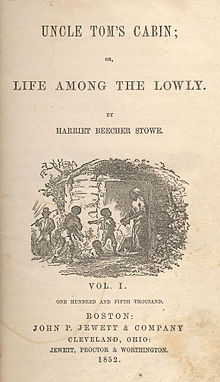 Title page for Volume I of the first edition of Uncle Tom's Cabin (1852) | |
| Author | Harriet Beecher Stowe |
|---|---|
| Original title | Uncle Tom's Cabin; or, Life Among the Lowly. |
| Illustrator | Hammatt Billings |
| Language | English |
| Genre | Novel |
| Published | March 20, 1852 (two volumes) |
| Publisher | John P. Jewett and Company, after serialization in The National Era beginning June 5, 1851 |
| Publication place | United States |
| OCLC | 1077982310 |
| 813.3 | |
| LC Class | PS2954 .U5 |
| Followed by | A Key to Uncle Tom's Cabin |
Uncle Tom's Cabin; or, Life Among the Lowly is an anti-slavery novel by American author Harriet Beecher Stowe. Published in two volumes in 1852, the novel had a profound effect on attitudes toward African Americans and slavery in the U.S., and is said to have "helped lay the groundwork for the [American] Civil War".[1][2][3]
Stowe, a Connecticut-born teacher at the Hartford Female Seminary, was part of the religious Beecher family and an active abolitionist. She wrote the sentimental novel to depict the reality of slavery while also asserting that Christian love could overcome slavery.[4][5][6] The novel focuses on the character of Uncle Tom, a long-suffering black slave around whom the stories of the other characters revolve.
In the United States, Uncle Tom's Cabin was the best-selling novel and the second best-selling book of the 19th century, following the Bible.[7][8] It is credited with helping fuel the abolitionist cause in the 1850s.[9] The influence attributed to the book was so great that a likely apocryphal story arose of Abraham Lincoln meeting Stowe at the start of the Civil War and declaring, "So this is the little lady who started this great war."[10][11]
The book and the plays it inspired helped popularize a number of negative stereotypes about black people,[12][13][3] including that of the namesake character "Uncle Tom". The term came to be associated with an excessively subservient person.[14] These later associations with Uncle Tom's Cabin have, to an extent, overshadowed the historical effects of the book as a "vital antislavery tool".[15] Nonetheless, the novel remains a "landmark" in protest literature,[16] with later books such as The Jungle by Upton Sinclair and Silent Spring by Rachel Carson owing a large debt to it.[17]
- ^ Kaufman 2006, p. 18.
- ^ Painter 2000, p. 245.
- ^ a b DeLombard 2012.
- ^ Kurian 2010, p. 580.
- ^ de Rosa 2003, On p. 122, de Rosa quotes Tompkins 1985, p. 145 that Stowe's strategy was to destroy slavery through the "saving power of Christian love"..
- ^ Tompkins 1985, On p. 141, Tompkins writes "Stowe conceived her book as an instrument for bringing about the day when the world would be ruled not by force, but by Christian love.".
- ^ DiMaggio 2014, p. 15.
- ^ Smith 2001, p. 221.
- ^ Goldner 2001, p. 82.
- ^ Stowe 1911, p. 203.
- ^ Vollaro 2009.
- ^ Hulser 2003.
- ^ Jamieson 2018, p. ??.
- ^ Jones 2019, pp. 1465–1467.
- ^ Appiah & Gates 2005, p. 544.
- ^ Smith 2008, p. 161.
- ^ Weinstein 2004, p. 13.